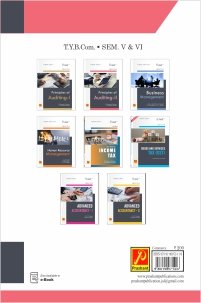Principles and Practice of Auditing - II
Authors:
Tags:
CA Y A Saindane, Ms S P Palve
ISBN:
SKU:
9788190971416
Book Language: English
Published Years: 2022
Pages: 176
Edition: First
Categories:
Account / Audit / Income Tax, TYBCom, वाणिज्य व व्यवस्थापन
₹200.00
- DESCRIPTION
- INDEX
- Investigation : 1. Investigation- 1.1. Meaning of Investigation, 1.2. Nature of Investigation, 1.3. Scope of investigation, 1.4. Objectives of Investigation / Need for Investigation, 1.5. Difference between Audit and Investigation, 1.6. Circumstances under which investigation is conducted, 1.7. Serious Fraud Investigation Office (SFIO), 1.8. Theory questions.
- Evaluation of Internal Control and Internal Check : 1.1. Meaning f Internal control, 1.2. Feature of Internal control, 1.3. Objectives of Internal control, 1.4. Scope of Internal control, 1.5. Factors affecting Internal control, 1.6. Advantages of Internal control, 1.7. Limitations of Internal control, 1.8. Evaluation of Internal control system, 1.9. Essentials of a good internal control system, 1.10. COSO model of Internal control, 2. Internal check system, 2.1. Test check – Meaning, 2.2. Features of Internal check system, 2.3. Objectives of Internal check system, 2.4. Advantages of Internal check system, 2.5. Limitations of Internal check system, 3.1. Routine checking and Test checking, 3.2. Meaning Test checking, 3.3. Surprise checks, 3.4. Audit in Depth, 3.5. Adoption of distinctive ticks, tick-marks or check marks, 4 – Elementary study of SA 265 “Communicating deficiencies in Internal Control to those charged with governance and management”, 4.1. Objective of SA 265, 4.2. Scope of SA 265
- Company Auditor : 1. Company Auditor- 1.1. Eligibility and Qualification of Auditors, 1.2. Disqualification of Auditor, 1.3. Appointment of an auditor as per the Companies Act, 2013, 1.4. Removal of an auditor as per the companies Act, 2013, 1.5. Rights/Powers of company auditor, 1.6. Duties of a Company Auditor, 1.7. Liabilities of a Company Auditor, 1.8. Remuneration of company auditor, 2. Professional conduct and ethics- 2.1. Introduction, 2.2. The concept of professional ethics, 2.3. Code of Ethics for Professional Accountants by ICAI, 2.4. Role of the ICAI in case of professional misconduct by a member, 3. Auditor’s role in corporate governance, 4. Evolution of Audit Committee, 5. Theory Questions.
- Audit of Limited Companies : 1. Company Audit- 1.1. Introduction, 1.2. Preliminaries to the Audit work of a Limited Company, 2. Audit of some transactions and items of a limited company – 2.1. Audit of Share Capital including Forfeiture of Shares, and Bonus Shares, 3. Audit of Debentures, 4. Theory Questions.
- Auditing in Computerized Information System (CIS) Environment : 1.1. Meaning of Computerised Information System, 1.2. Characteristics of CIS Environment, 1.3. Approaches to Computerised Information System (CIS) auditing, 1.4. Distinction between manual accounting audit and Computerised accounting audit, 1.5. Computer frauds and computer virus, 1.6. Concept of audit Software, 1.7. Theory Questions.
- Audit Report : 1.1. Nature of audit report, 1.2. Importance of audit report, 1.3. Contents of audit report, 1.4. Types of audit report, 1.5. Distinguish between Audit Reports and Audit Certificates, 1.6. Notes on accounts /Notes to accounts, 1.7. Distinction between notes and qualification, 1.8. Theory Questions.
RELATED PRODUCTS
Related products
-
Management Accounting
₹395.00 -
Auditing
₹275.00 -
Career Management
₹110.00 -
व्यावसायिक अर्थशास्त्र
₹250.00








